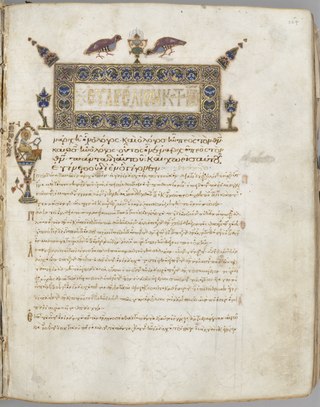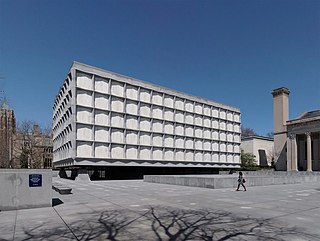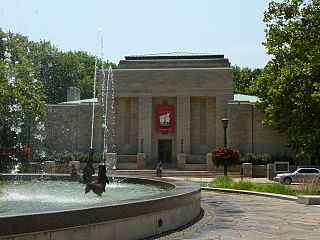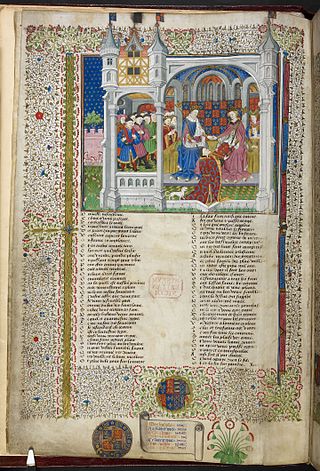
An illuminated manuscript is a formally prepared document where the text is decorated with flourishes such as borders and miniature illustrations. Often used in the Roman Catholic Church for prayers and liturgical books such as psalters and courtly literature, the practice continued into secular texts from the 13th century onward and typically include proclamations, enrolled bills, laws, charters, inventories, and deeds.

Cambridge University Library is the main research library of the University of Cambridge. It is the largest of over 100 libraries within the university. The library is a major scholarly resource for members of the University of Cambridge and external researchers. It is often referred to within the university as the UL. Thirty-three faculty and departmental libraries are associated with the University Library for the purpose of central governance and administration, forming "Cambridge University Libraries".

The Beinecke Rare Book & Manuscript Library is the rare book library and literary archive of the Yale University Library in New Haven, Connecticut. It is one of the largest buildings in the world dedicated to rare books and manuscripts and is one of the largest collections of such texts. Established by a gift of the Beinecke family and given its own financial endowment, the library is financially independent from the university and is co-governed by the University Library and Yale Corporation.

The Gutenberg Bible, also known as the 42-line Bible, the Mazarin Bible or the B42, was the earliest major book printed in Europe using mass-produced metal movable type. It marked the start of the "Gutenberg Revolution" and the age of printed books in the West. The book is valued and revered for its high aesthetic and artistic qualities and its historical significance.

Octavo, a Latin word meaning "in eighth" or "for the eighth time", is a technical term describing the format of a book, which refers to the size of leaves produced from folding a full sheet of paper on which multiple pages of text were printed to form the individual sections of a book. An octavo is a book or pamphlet made up of one or more full sheets on which 16 pages of text were printed, which were then folded three times to produce eight leaves. Each leaf of an octavo book thus represents one eighth the size of the original sheet. Other common book formats are folios and quartos. Octavo is also used as a general description of the size of books that are about 8 to 10 inches tall, and as such does not necessarily indicate the actual printing format of the books, which may even be unknown as is the case for many modern books. These terms are discussed in greater detail in book sizes.

The National Library of Wales, in Aberystwyth, is the national legal deposit library of Wales and is one of the Welsh Government sponsored bodies. It is the biggest library in Wales, holding over 6.5 million books and periodicals, and the largest collections of archives, portraits, maps, and photographic images in Wales. The Library is also home to the national collection of Welsh manuscripts, the National Screen and Sound Archive of Wales, and the most comprehensive collection of paintings and topographical prints in Wales. As the primary research library and archive in Wales and one of the largest research libraries in the United Kingdom, the National Library is a member of Research Libraries UK (RLUK) and the Consortium of European Research Libraries (CERL).

The National Széchényi Library (OSZK) is a library in Budapest, Hungary, located in Buda Castle. It is one of two Hungarian national libraries, the other being University of Debrecen Library.

An Ex Libris from ex-librīs, also known as a bookplate, is a printed or decorative label pasted into a book, often on the front endpaper, to indicate ownership. Simple typographical bookplates are termed "book labels".
Ruth E. Adomeit was an American writer, editor, collector of miniature books and philanthropist.
Hans Peter Kraus, also known as H. P. Kraus or HPK, was an Austrian-born book dealer described as "without doubt the most successful and dominant rare book dealer in the world in the second half of the 20th century" and in a league with other rare book dealers such as Bernard Quaritch, Guillaume de Bure and A.S.W. Rosenbach. Kraus specialized in medieval illuminated manuscripts, incunables, and rare books of the 16th and 17th centuries, but would purchase and sell almost any book that came his way that was rare, valuable and important. He prided himself in being "the only bookseller in history...to have owned a Gutenberg Bible and the Psalters of 1457 and 1459 simultaneously," stressing that "'own' here is the correct word, as they were bought not for a client's account but for stock."

Quarto is the format of a book or pamphlet produced from full sheets printed with eight pages of text, four to a side, then folded twice to produce four leaves. The leaves are then trimmed along the folds to produce eight book pages. Each printed page presents as one-fourth size of the full sheet.

The British Library is a research library in London that is the national library of the United Kingdom. It is one of the largest libraries in the world. It is estimated to contain between 170 and 200 million items from many countries. As a legal deposit library, the British Library receives copies of all books produced in the United Kingdom and Ireland, including a significant proportion of overseas titles distributed in the UK. The Library is a non-departmental public body sponsored by the Department for Culture, Media and Sport.

The Lilly Library, located on the campus of Indiana University in Bloomington, Indiana, is an important rare book and manuscript library in the United States. At its dedication on October 3, 1960, the library contained a collection of 20,000 books, 17,000 manuscripts, more than fifty oil paintings, and 300 prints. Currently, the Lilly Library has 8.5 million manuscripts, 450,000 books, 60,000 comic books, 16,000 mini books, 35,000 puzzles, and 150,000 sheets of music.

Museum Meermanno – House of the Book, formerly called Museum Meermanno-Westreenianum, is a museum named after Willem Hendrik Jacob van Westreenen van Tiellandt on the Prinsessegracht 30 in The Hague. It is remarkable for its collection of sculpture, books, etchings, and paintings, but is most attractive to visitors for its accurate upkeep of the 18th century Herenhuis interior with period furnishings and collectibles.

The Royal manuscripts are one of the "closed collections" of the British Library, consisting of some 2,000 manuscripts collected by the sovereigns of England in the "Old Royal Library" and given to the British Museum by George II in 1757. They are still catalogued with call numbers using the prefix "Royal" in the style "Royal MS 2. B. V". As a collection, the Royal manuscripts date back to Edward IV, though many earlier manuscripts were added to the collection before it was donated. Though the collection was therefore formed entirely after the invention of printing, luxury illuminated manuscripts continued to be commissioned by royalty in England as elsewhere until well into the 16th century. The collection was expanded under Henry VIII by confiscations in the Dissolution of the Monasteries and after the falls of Henry's ministers Cardinal Wolsey and Thomas Cromwell. Many older manuscripts were presented to monarchs as gifts; perhaps the most important manuscript in the collection, the Codex Alexandrinus, was presented to Charles I in recognition of the diplomatic efforts of his father James I to help the Eastern Orthodox churches under the rule of the Ottoman Empire. The date and means of entry into the collection can only be guessed at in many if not most cases. Now the collection is closed in the sense that no new items have been added to it since it was donated to the nation.
The News Letter of the LXIVmos was a near-monthly publication edited by book collector James D. Henderson that ran from 1927 to 1929.

David Anton Randall was an American book dealer, librarian and bibliographic scholar. He was head of Scribner's rare book department from 1935 to 1956, librarian of the Lilly Library and Professor of Bibliography at Indiana University. Randall was responsible for the sale of two copies of the Gutenberg Bible. As a practitioner of bibliology with a bibliophiliac addiction, a raconteur of history of books, and an avid collector, he developed a keen appreciation for books as physical objects—including the tasks of collecting, cataloging, finding and preserving them.
Achille St. Onge was a publisher of miniature books from Worcester, Massachusetts. St. Onge began publishing miniature books as a hobby in 1935, and by the time he stopped publishing in 1977, he had created 48 miniature books, which are prized by collectors.
John McLaren Emmerson (1938-2014) was an Australian physicist, barrister, and collector of rare books. He published and taught on nuclear and particle physics at the University of Oxford, was an authority on Intellectual Property law, and amassed a book collection reflecting his interest in 17th century British history. His is one of the world's largest collections of rare English printed books relating to the reign of Charles I and the English Civil War.
A Book of Ryhmes is a miniature book of poems by Charlotte Brontë. It was written in 1829 when Brontë was aged 13. The book is part of the collections of the Brontë Parsonage Museum in Haworth, West Yorkshire.





![The Ellen Terry Shakespeare Glasgow: David Bryce and Son; New York; Frederick A. Stokes Co. [1904]. Remains the smallest edition of the complete works of Shakespeare. Albert and Shirley Small Special Collections Library. Photograph by Molly Schwartzburg. Ellen Terry Shakespeare.jpg](http://upload.wikimedia.org/wikipedia/commons/thumb/6/68/Ellen_Terry_Shakespeare.jpg/220px-Ellen_Terry_Shakespeare.jpg)
![Popular miniature book, The Lord's prayer: [in 7 languages], by publisher Waldmann & Pfitzer in 1952. Advertised as "The World's Smallest Book" at 5 x 5 mm. Copy seen here in the Mills College Heller Rare Book Room, Fine Press Collection. The miniature "The Lord's Prayer" in it's plexiglass container.jpg](http://upload.wikimedia.org/wikipedia/commons/thumb/b/bf/The_miniature_%22The_Lord%27s_Prayer%22_in_it%27s_plexiglass_container.jpg/220px-The_miniature_%22The_Lord%27s_Prayer%22_in_it%27s_plexiglass_container.jpg)













